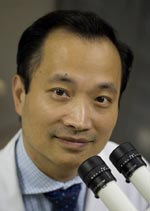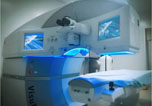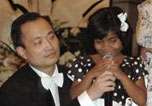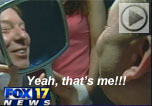- Over 55,000 LASIK and cataract procedures (including on over 4,000 doctors)
- The FIRST center in TN to offer Laser Cataract Surgery
- Introduced bladeless all-laser LASIK to the state
- Implanted the state's first FOREVER YOUNG™ Lens
- The first surgeons in the US to perform a new Intacs surgery to treat keratoconus
- Helped patients from 40 states and 55 countries
- International referral center for cataract surgery and LASIK complications
- Read Dr. Wang's book: LASIK Vision Correction
Why did you decide to have LASIK? Why did you choose Dr. Wang? How has your life changed since your LASIK procedure?
What is your advice for people considering LASIK?
Click to read more
| Article Library | Print This Page |
3D image-guided high-definition LASIK – new microsurgical technology makes worldwide debut in Nashville
Wang Vision Cataract and LASIK Center, Nashville, TN

By: CINDY SANDERS
After working with TrueVision® to develop and modify the signal capturing and processing system of the company’s stereoscopic microsurgical technology, Ming Wang MD, PhD, performed the world’s first three-dimensional, image-guided, high-definition LASIK procedure with the customized equipment on May 27 at Wang Vision 3D Cataract & LASIK Center in Nashville.
California-based TrueVision Systems, Inc. received U.S. Food and Drug Administration (FDA) clearance earlier this year for the company’s refractive cataract system, which displays the surgical field of view in real-time on a 3D, flat-panel display in the operating room. Wang, who in addition to his medical degree has a doctorate in laser physics, is one of only a handful of surgeons in the United States using the system for cataract surgery and worked with the company to customize the image capturing and enhancement device for the off-label use for LASIK.
“We were very excited to be the first in the world to perform the 3D, image-guided, high-definition LASIK procedure,” said Wang, who is also a clinical associate professor of ophthalmology for the University of Tennessee. “In a standard LASIK procedure, the surgeon looks through a traditional microscope with the naked eye. There is no signal processing or image enhancement at all. What you see is what you get. Therefore, our ability to visualize during surgery is very limited by our natural capability to see with only our own eyes.”
Enhanced and Magnified Depth of Field
In the nearly two decades since the FDA first approved the excimer laser to treat patients with mild-to-moderate nearsightedness … and later to correct astigmatism and farsightedness … there have been refinements to the procedure but the basic technology has remained largely unchanged.
Wang said the TrueVision system represents the first new development in surgery technology in many years. The system creates a magnified and enhanced view of the entire surgical field allowing for more precise laser focusing.
Wang explained, “The precision of a LASIK procedure is very much dependent upon where a surgeon places the laser beam on the cornea for treatment. Given the fact that a human eyeball is very small in size, even a minor amount of movement error by the surgeon or the laser beam can cause the laser to hit the wrong spot on the cornea, which can lead to significant treatment complication and hence compromised vision in a patient.”
He continued, “With this new 3D, high-definition microsurgical system, the image of an eyeball is optically captured and magnified to a size that is over 100 times larger than the size of the eyeball itself. Using the image-guided computer technology, we are now able to much more accurately move the laser beam to precise locations on the cornea for treatment. This technology has also, for the first time, allowed us to create a much deeper and more enhanced depth of field on the eye, which has enabled us to focus the laser beam more precisely on the vertical axis on any level of the corneal tissue that we want to focus and treat.”
Overlapping Images for Astigmatism Correction
The new TrueVision LASIK technology also has a novel feature to improve the precision of astigmatism correction. With traditional LASIK, Wang explained, it can be challenging for surgeons to precisely locate and identify corneal surface features such as the axis of corneal astigmatism because the pre-operative corneal map cannot be shown simultaneously and in real time within the surgical field under a traditional microscope.
“However, by capturing the surgical field, digitally processing and enhancing it, then overlapping it with the pre-operative corneal topography and displaying the composite dual map on the 3D, high-definition screen during surgery, we are able to — for the first time — accurately determine the orientation of axis of astigmatism allowing a precise placement of the laser beam on the eye for astigmatic treatment,” he said. “As a result, our patients have now enjoyed a new and improved high-definition vision after LASIK.”
Extending Human Ability
“Basically, having this new 3D technology is like going from an old x-ray film to a new 3D CT scan. Just as robotic surgery has extended the human’s natural capability to reach beyond our own hands, the new 3D, image-guided, high-definition microsurgical technology has extended our own natural human capability of visualization beyond just what we can see with our own eyes,” Wang summed up, adding that he believes this is the beginning of a new era in microsurgical technology that will have an impact beyond the field of ophthalmology.
The first patient worldwide to undergo the new TrueVision LASIK procedure was Farah Jai-Aden, a 28-year-old truck and taxi driver from Atlanta. Jai-Aden understood this was an off-label use of the new technology but was excited to be the first patient to undergo the procedure. Wang said Jai-Aden reported that he was able to see better than he ever has before … even with glasses.
Although Wang is the only one in Tennessee currently offering TrueVision technology for either LASIK or cataract surgery, he is hopeful its popularity soon will spread. “We are organizing national and international teaching conferences for this new 3D microsurgical technology, and it is my hope that all eye surgeons will begin to use this wonderful new technology to improve the visual outcome of their patients.”
Our new texbooks
A 501c(3) charity that has helped patients from over 40 states in the US and 55 countries, with all sight restoration surgeries performed free-of-charge.




















